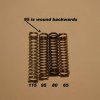Im going to recheck my popoffs.... any idea where they should be on a stock setup for a 96 gtx
I hope this makes some sense and is helpful. Make sure while those carbs are off though, you pilot holes are clear. Remove the low speed needle and pilot jet if you have to, to clear all junk out of the low speed circuit.
http://www.mikuni.com/pdf/sbn_manual.pdf
So yep, it's best to start from scratch and verify all the right parts and settings for your configuration. Metering seat orifice, metering spring color, pilot and high speed jet size. Could be someone has replaced the springs with the wrong ones, in which case the pop won't occur where it should, according to Mikuni's table.
For instance, the silver 65 gram spring (the lightest of four) with 1.5 seat should pop very near the value given in Mikuni's table: 32psi Seems like on average, next size up spring pops ~5psi higher (see table).
Down low, a lower pop than specified will flow fuel sooner at engine vacuum thus if your springs were changed to the wrong ones and now are too stiff or the arms were bent to compensate, you might experience acceleration hesitation or even lean idle issues where the motor runs out of fuel and stops firing completely.
Make sure the metering arm levers are at the correct height, ie: level with the chamber bottom (I barely snag a razor blade straight edge dragging across the top).
Spring selection is most often airbox dependent. This is why different skis with the dame motor have a different spring and/or low speed jet. Swapping carbs that aren't calibrated for the air box can leave you scratching your head.
If your springs were changed to too soft, you might have too much fuel and a lot of time is spent burbling on the excess fuel while it's clearing out (too much fuel can cause a black spooge oil stain on the transom and foul plugs too quickly with soot).
Adding further to the confusion in some cases, some springs were shimmed to adjust the pop pressure and there's no notation of the shim existing or thickness. Guess what happens when the carb is disassembled and tossed in a parts washer?
Personal question: Why is it my black is someone else's brown and another guy says it looks green to him, LOL? I can't imagine a lighter spring would be used for carbs with an a-pump, I'd think the heavier spring, if any change, would go with the a-pump.
"all 787 carbs without the accellerator pump use the brown 80 gram springs"
http://www dot.pwctoday dot com/showthread.php?t=337353
I'd try a 65 gram spring, if you wanted to lower the pop a few psi and get a tiny bit more fuel. Next step would be a larger pilot jet. These carbs are aging, the tiny passages have more corrosion in them than when they were new. OR MAYBE your crank seals are leaking air? I don't know but this is all part of having fun, right?






